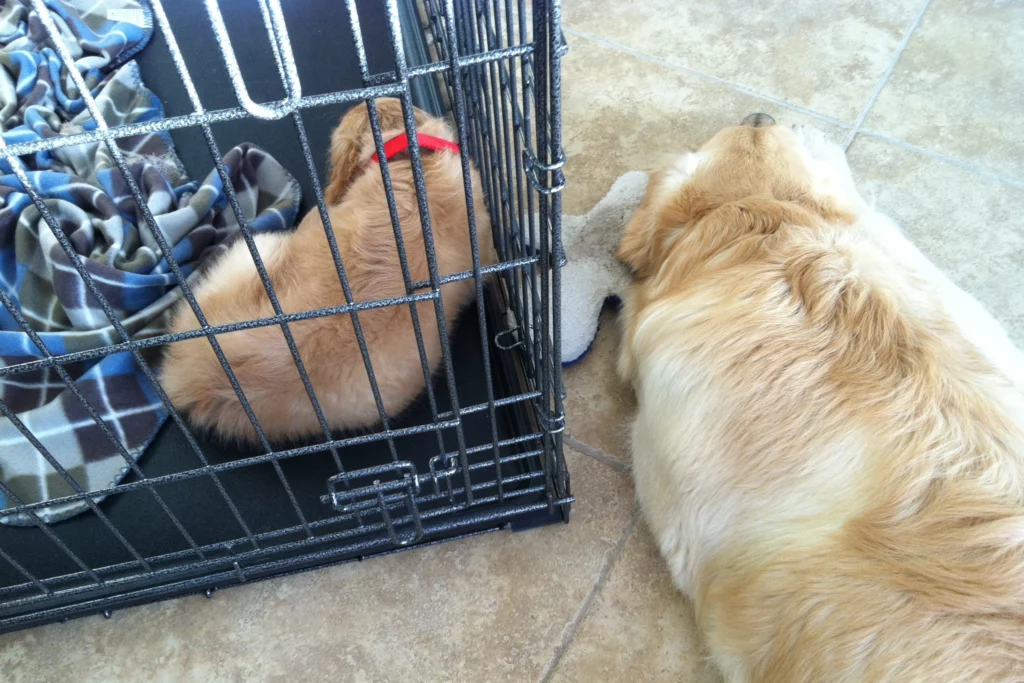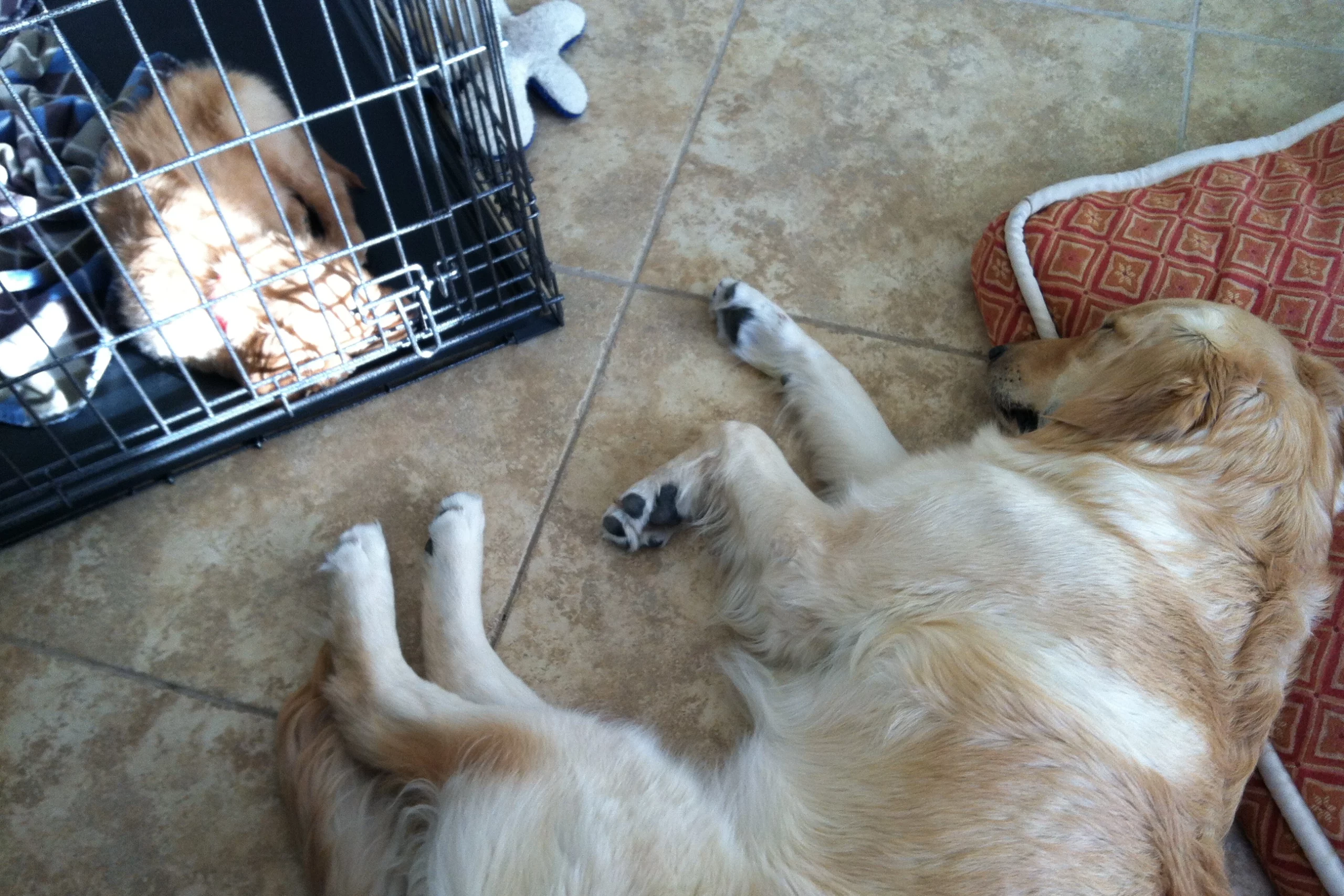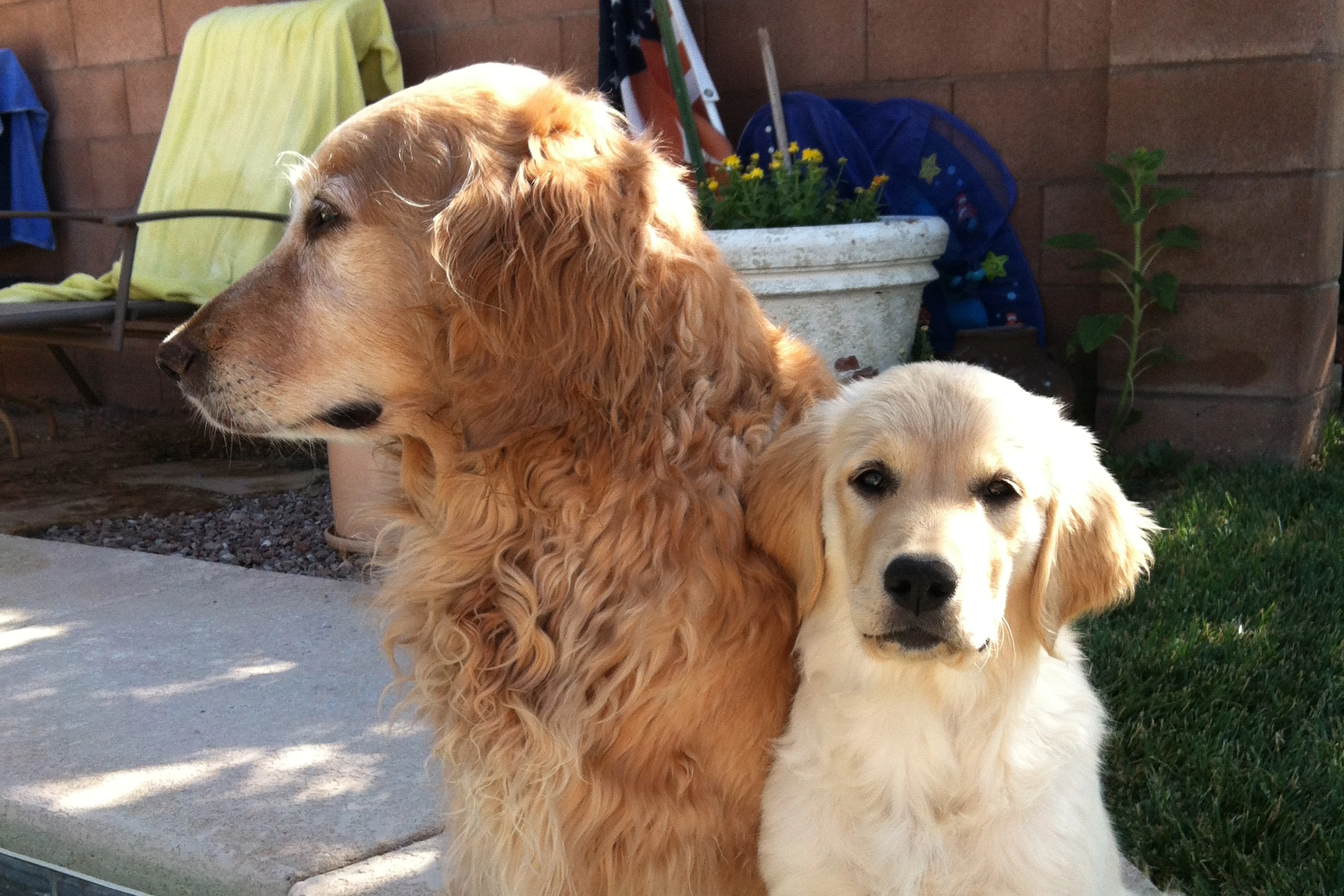This post may contain ads and affiliate links and we may earn a small commission when you click on the links at no additional cost to you. As an Amazon Affiliate, we earn from qualifying purchases. You can read our full disclaimer here.
The Best Sleeping Arrangements for New Puppy and Older Dog

When it comes to the sleeping arrangements for a new puppy and an older dog, things can get a bit complex.
You’re introducing a young, energetic, possibly overzealous puppy into the calm, established routine of your older dog. You want to ensure everyone’s comfortable, right?
Not to mention that peaceful nights can become a distant memory if your furry friends can’t settle down harmoniously.
In this guide, we’ll navigate this delicate situation together. We will explore the intricate dynamics between your older dog and their new roommate, and how to foster a serene and restful environment for both.
It’s all about understanding their unique needs, providing the right spaces, and adopting the best behavioral training practices.
Sleeping Arrangements for New Puppy and Older Dog
Every dog is unique. Your older dog may love peace and quiet. Maybe your new puppy can’t get enough of playtime. It’s all about getting to know them.
Personality Check
First, think about their personalities. Maybe your older dog likes to be left alone. Perhaps the new pup is a little shy. Understanding these traits is key to figuring out their sleeping arrangements.
Health Factors
Next, take health into consideration. Older dogs might have some health issues. They might need a special bed for their joints. Puppies are still growing. A comfortable bed can aid their development.
Initial Steps for Sleeping Arrangements for New Puppy and Older Dog: Creating Separate Spaces
The first step to a peaceful house is setting up separate spaces. Here’s a simple guide on how to do it.
Separate Beds
Give each dog their own bed. Your older dog might enjoy a raised bed for support. A snug, secure bed might be perfect for your puppy. It’s all about what makes them comfortable.
Perfect Placement
The location of the beds matters. Try to put them in the same room. This way, they can feel like part of the family. But remember to maintain a good distance between the two. Personal space is important too.
Bed Boundaries
Now, here’s a golden rule: keep their spaces exclusive. Do not let the puppy invade the older dog’s bed and vice versa. Respecting these boundaries is a crucial step to ensure peaceful coexistence.
Sleeping Arrangements for New Puppy and Older Dog: Crate Training

Crate training is more than just containment; it’s about creating a safe and comfortable space for your puppy. It can play a critical role in establishing a routine, including sleeping arrangements.
Picking the Perfect Crate
The crate you choose should be comfortable and appropriately sized. It should allow your puppy to stand, turn around, and lie down without any restriction.
But keep in mind, an overly spacious crate may encourage them to use a corner as a bathroom spot.
With a plush cushion for comfort and a removable tray for effortless cleaning, it’s a perfect blend of convenience and elegance.
Crate Comforts
Once you have the right crate, it’s time to make it inviting:
- Add a soft blanket or a comfortable bed.
- Toss in a few safe toys for them to play with.
- Consider including an item with your scent on it to help them feel secure.
Gradual Introduction
Introducing your puppy to the crate should be a gradual process:
- Allow them to explore it at their own pace.
- Use treats or toys to encourage them to enter the crate, but leave the door open initially.
- Begin to close the door for short periods once they’re comfortable, gradually increasing the duration.
Building a Routine
Establishing a crate routine is crucial. Begin with short daytime naps in the crate, then gradually extend to longer periods and eventually nighttime sleep.
Remember, consistency is key, and rewarding good behavior will help your puppy associate the crate with positive experiences.
Don’t forget, crate training is an excellent tool for establishing boundaries and routines but should never be used as a punishment. Keep the experiences positive, and your puppy will view the crate as their personal safe and cozy retreat.
Sleeping Arrangements for New Puppy and Older Dog: Crate Training Edition

Crate training can be a journey filled with unique experiences, as we discovered with our own puppy Goldendoodle, Gunner, and our Golden Retriever, Daisy.
A Special Setup for Sleeping Arrangements for New Puppy and Older Dog
For us, the placement of the crate played a significant role in the training process. We decided to place Gunner’s crate on top of a nightstand right next to our bed. This arrangement allowed our new pup to still feel close to us, which is very comforting to them, especially during the early days of training.
Comforting with Scent
One of the challenges of crate training is the whining or barking that can come with it. This often happens when puppies are adjusting to their new environment and routine.
When Gunner or Daisy started to whine or bark, we had a simple yet effective solution. I would stick my fingers into the crate. They could sniff my scent, which seemed to comfort them and helped them settle down.
This personal experience shows that crate training is more than just about the crate itself. It’s about making your puppy feel secure, loved, and comfortable in their new sleeping arrangement.
Sleeping Arrangements for New Puppy and Older Dog: Behavioral Training for Sleep Times
While creating a peaceful environment is important, the key to success lies in teaching your dogs the right behavior. Here’s how to go about it:
Setting Boundaries
- Establish clear territories: Make sure each dog knows their sleeping area – your older dog’s bed and the puppy’s crate or bed.
- Use commands: Use firm but gentle commands to keep each dog in their designated areas.
- Consistency: Maintain this boundary setting consistently until both dogs understand and respect the rule.
Reward Good Behavior
Positive reinforcement goes a long way in training dogs.
- Reward obedience: When your puppy enters their crate on their own or your older dog respects the puppy’s crate, reward them.
- Use treats and praises: A treat, a word of praise, or some petting can help reinforce this good behavior.
Gradual Integration with Sleeping Arrangements for New Puppy and Older Dog
Now comes the task of integrating your dogs into a shared sleeping space. This process should be slow and steady.
Start Small with Sleeping Arrangements for New Puppy and Older Dog
- Choose a quiet time: Start during a quiet time when both dogs are calm.
- Supervise: Stay with them in this shared space and keep a close eye on their reactions.
Respect Individual Comfort Zones
Even while promoting togetherness, their individual spaces must be respected.
- Allow retreat: Let your older dog retreat to their bed and your puppy to their crate whenever they want.
- Respect boundaries: Do not force them to share space if they are not comfortable.
Monitor Progress
- Observe interactions: Keep an eye on how they behave when they’re together. If they’re comfortable, gradually increase their shared time.
- Adjust as necessary: If you notice discomfort or aggression, dial back and give them more individual space. Try again later when they’re ready.
Sleeping Arrangements for New Puppy and Older Dog: Choosing the Right Sleep Aids and Equipment
Having the right tools at your disposal can make a big difference when introducing a new puppy to your older dog. Here’s a guide to help you pick the best sleeping equipment for your pets:
Types of Dog Beds
- Orthopedic beds: These are ideal for older dogs as they offer extra support for joints.
- Nesting beds: Puppies might prefer these because of their cozy, enclosed design.
- Heated beds: Useful for dogs that get cold easily or have arthritis.
Crates and Other Sleep Aids
- Crate size: Your crate should be big enough for your puppy to stand, turn around, and lie down, but not so big that they can designate a bathroom corner.
- Comfortable bedding: Make the crate cozy with a soft bed or blanket.
- Crate location: Place the crate in a quiet, low-traffic area, but where your puppy can still feel part of the family.
Making the Right Choice
- Consider your pet’s needs: Does your older dog have arthritis? Does your puppy prefer enclosed spaces?
- Assess your space: Ensure the equipment fits well within your living space without causing inconvenience.
Troubleshooting Common Issues
Even with the best arrangements, you might encounter a few bumps on the road. Here’s how to deal with them:
Dealing with Disturbances
- One dog disturbing the other: If your puppy is disturbing your older dog (or vice versa), go back to reinforcing boundaries.
- Territorial disputes: If disputes arise, give them more individual space and reintroduce shared space gradually.
When to Seek Professional Help
- Persistent issues: If issues persist despite your efforts, it might be time to call in a professional.
- Aggression: Aggressive behavior is a clear sign that you need a professional dog behaviorist’s help.
- Health concerns: If your older dog seems to be in discomfort or your puppy isn’t settling in, consult with a vet. Professional advice is invaluable in ensuring the wellbeing of your pets.
Case Study: Personal Experience with Lucky and the New Puppy

Reflecting on our own experiences can be a great learning tool. In our case, introducing a new Golden Retriever puppy to our 8-year-old dog, Lucky, provided valuable insights.
Our initial attempts were met with resistance. Lucky was used to being the only pet and did not warm up to the new puppy immediately. However, we remained patient and consistent with our training efforts.
We placed the puppy’s crate next to our bed to help with the transition and established clear boundaries for both dogs. During the process, we also learned the importance of rewarding good behavior, which significantly helped reinforce positive behaviors in both dogs.
Perhaps the most vital lesson we learned was that every dog has its own pace of adapting to new changes. Being patient, observant, and empathetic towards our pets’ needs made this transition smoother and more successful.
Wrapping Up Sleeping Arrangements for New Puppy and Older Dog
Introducing a new puppy to an older dog and setting up their sleeping arrangements is indeed a journey. It requires patience, observation, and understanding from you as a pet parent.
Remember, every dog is unique, and they all adapt to changes differently. Ensure you’re tailoring the strategies outlined in this guide to best suit your pets’ needs.
Use appropriate sleep aids and equipment, and don’t hesitate to seek professional help if required.
Ultimately, your love and care will guide them through this transition. Trust the process, keep a positive attitude, and before you know it, your new puppy and older dog will be peacefully cohabitating, even during sleep times.
-

Coffee Mug – In Dog Coffees I’ve Only Had One
Price range: $11.95 through $14.95 Select options This product has multiple variants. The options may be chosen on the product page

